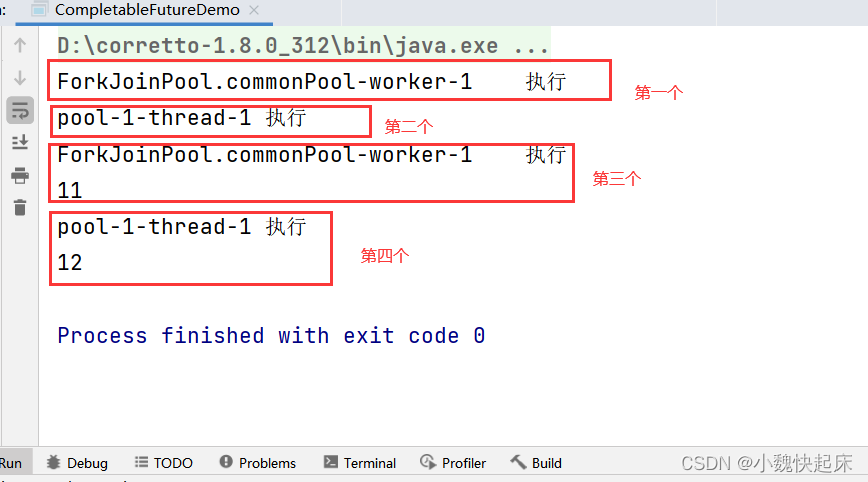-
Java并发编程—CompletableFuture的介绍和使用
在博主上一篇博客介绍中,Java并发编程—java异步Future的迭代过程_小魏快起床的博客-CSDN博客,这里面给大家分析了Future的使用过程和一些存在的问题,那么针对里面出现的阻塞问题,博主将在这一篇文章给大家介绍清楚
🍏一、认识新的类CompletableFuture
🍄1、CompletableFuture类在java源代码中的样子:
public class CompletableFutureimplements Future , CompletionStage { } 🍄2、CompletableFuture类的架构图

🍄3、再回顾一下博主上一篇博客中讲的FutureTask类结构图:

🚗 综上:这个新的CompletableFuture类实现了和FutureTask一样的Future类,所以CompletableFuture类里面有FutureTask关于异步任务的这些特性。同时,CompletableFuture还实现了CompletionStage接口,而真正解决之前的阻塞问题的就是咱们CompletionStage接口,而CompletableFuture进行了一个实现,所以就给大家讲解的是CompletableFuture类;
🍏 二、CompletableFuture和CompletionStage源码分别介绍
🍄 1、接口CompletionStage:
①、CompletionStage代表异步计算过程中的某一个阶段,一个阶段完成以后可能会触发另外一个阶段。
②、一个阶段的计算执行可以是一个Function,Consumer或者Runnable。
③、一个阶段的执行可能是被单个阶段的完成触发,也可能是由多个阶段一起触发;
🚗 总结:代表异步计算过程中的某一个阶段,一个阶段完成以后可能会触发另外一个阶段,类似Linux系统的管道分隔符传参数,说人话就是一阶段完成了,需要做二阶段,这个时候二阶段可能会依靠一阶段的结果来执行一些业务。
🍄 2、类CompletableFuture:
CompletableFuture是对Future的扩展和增强。CompletableFuture实现了Future接口,并在此基础上进行了丰富的扩展,完美弥补了Future的局限性,同时CompletableFuture实现了对任务编排的能力。借助这项能力,可以轻松地组织不同任务的运行顺序、规则以及方式。从某种程度上说,这项能力是它的核心能力。而在以往,虽然通过CountDownLatch等工具类也可以实现任务的编排,但需要复杂的逻辑处理,不仅耗费精力且难以维护。
🚗 总结:CompletableFuture牛逼就完事儿,FutureTask可以做的这个都可以做,并且还可以做一些Future不能做的事;
🍏 三、CompletableFuture的方法介绍
介绍一下CompletableFuture里面的方法:

runAsync 创建无返回值的异步任务
supplyAsync 创建有返回值的异步任务代码案例:
- public static void main(String[] args) throws ExecutionException, InterruptedException {
- // 创建线程池。线程池的"最大池大小"和"核心池大小"都为1(THREADS_SIZE),"线程池"的阻塞队列容量为1(CAPACITY)。
- ThreadPoolExecutor pool = new ThreadPoolExecutor(
- 1,
- 1,
- 0,
- TimeUnit.SECONDS,
- new ArrayBlockingQueue
(1) - );
- //第一个基本方法runAsync
- CompletableFuture
async1 = CompletableFuture.runAsync(() -> { - System.out.println(Thread.currentThread().getName() + "\t" + "执行");
- });
- //第二个基本方法runAsync,带线程池的
- CompletableFuture
async2 = CompletableFuture.runAsync(() -> { - System.out.println(Thread.currentThread().getName() + "\t" + "执行");
- }, pool);
- //第三个基本方法supplyAsync
- CompletableFuture
async3 = CompletableFuture.supplyAsync(() -> { - System.out.println(Thread.currentThread().getName() + "\t" + "执行");
- return 11;
- });
- System.out.println(async3.get());
- //第四个基本方法supplyAsync
- CompletableFuture
async4 = CompletableFuture.supplyAsync(() -> { - System.out.println(Thread.currentThread().getName() + "\t" + "执行");
- return 12;
- }, pool);
- System.out.println(async4.get());
- //关闭线程池
- pool.shutdown();
- }
🚗 总结:在上面的代码中,每个方法都有2种使用方法,无非就是携带线程池的区别,如果不提供自定义线程池的话,方法内部会用默认的线程池;
分别执行的效果如下,有数字的是有返回值的,工作中用哪种,取决于实际应用场景:

以上是对这个类和一些方法的初步解析
🍏 四、用CompletableFuompleture做之前的事儿
之前博主的想法是在主线程中开启一个子线程,然后子线程进行一个计算,然后返回结果值,那么用CompletableFuompleture来做一些试试:
- //1、创建一个有返回值的异步任务
- CompletableFuture
async = CompletableFuture.supplyAsync(() -> { - try {
- //延迟2s
- TimeUnit.SECONDS.sleep(2);
- } catch (InterruptedException e) {
- e.printStackTrace();
- }
- return 11;
- });
- System.out.println("主线程正常执行");
- //获取异步任务的返回值
- System.out.println(async.get());
- System.out.println("结束");
效果如下:

分析:这样执行是没啥问题的,但是还是出现了阻塞的问题,明明都说了换类,都说了这个好用,为啥还会出现阻塞呢,这个显然是我们使用错误了,接下来就给大家演示正确的使用方法
🍏 五、CompletableFuompleture正确的使用方法:
博主想做这么一件事儿,开启一个异步任务,第一步计算1+2的值,然后将这个值再提供给下一步做+3的操作,然后输出最后的结果,实现一个多线程异步任务编排:
- public static void main(String[] args) throws Exception {
- //1、创建一个线程池
- ThreadPoolExecutor pool = new ThreadPoolExecutor(
- 1,
- 1,
- 0,
- TimeUnit.SECONDS,
- new ArrayBlockingQueue
(1) - );
- //2、创建异步编排任务
- CompletableFuture.supplyAsync(() -> {
- //延迟2s
- try { TimeUnit.SECONDS.sleep(2); } catch (InterruptedException e) { }
- //做一下加法然后返回结果
- return 1 + 2;
- }, pool).thenApply(e -> {
- //根据上一步的结果+3
- return e + 3;
- }).whenComplete((v, f) -> {
- //判断是否有异常,如果没有就输出结果值
- if (f == null) {
- System.out.println("结果值:" + v);
- }
- }).exceptionally(e -> {
- //异常输出,whenComplete里面的f不为null时触发
- e.printStackTrace();
- return null;
- });
- //3、主线程执行输出
- System.out.println("输出main线程");
- //4、关闭线程池
- pool.shutdown();
- }
效果如下:

🚗 总结:在这个案例中,没有用get()方式,用了一些CompletableFuture类里面的自带方法,这就是真正实现了一个异步任务编码的实现,博主这里只用了很简单的例子,铁子们在工作中,完全可以用这种方式来提高效率,这个可以用在数据统计中;
🍏 六、常用方法介绍
在上面的案例中用到了一些方法,在这里可以做一个介绍:
🍄 1、thenApply / thenApplyAsync 异步回调
前者是由执行job1的线程立即执行job2,即两个job都是同一个线程执行的
后者是将job2提交到线程池中异步执行,实际执行job2的线程可能是另外一个线程🍄 2、exceptionally whenComplete handle
whenComplete 未发生异常正常返回值发生异常就返回异常,一般配合exceptionally使用
exceptionally确认会发生异常
handle 基本一致 区别在于 handle 有返回值🍄 3、thenAccept / thenRun
thenAccept 同 thenApply 接收上一个任务的返回值作为参数,但是无返回值;
thenRun 的方法没有入参,也没有返回值🍕:博主写博客主要是分享技术,分享技术的一个迭代过程,分享技术中发生的问题如何进行解决,欢迎各位铁子留言讨论;
-
相关阅读:
寻找单身狗
JS Promise 之 Hello World
java高级---->Java动态代理的原理
数据结构与算法之顺序表详解
【scipy 基础】--傅里叶变换
CSS盒子模型及属性
Vue--》简述组件的数据共享
索引index
创建型模式-原型模式
《机器学习实战》学习笔记(十二)
- 原文地址:https://blog.csdn.net/qq_52545155/article/details/128167519